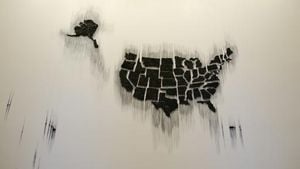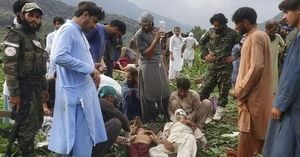Protests against President Trump’s mass deportation plans erupted across the United States, with communities expressing deep concern over the anxiety and fear generated within immigrant populations. Demonstrators gathered in cities like North Little Rock, Mobile, and San Diego to voice their discontent and solidarity with affected families.
On Friday evening, dozens of protesters assembled at the North Little Rock City Hall to protest the U.S. Immigration and Customs Enforcement (ICE) arrests targeting what the administration describes as "criminal illegal immigrants." Protest organizer Angela Baltazar voiced the core sentiment of the protest, stating, "I have seen how hard my parents have tried here and I know they are not a danger to society. I know the way they are treating us is so unfair." The rally underscored the persistent fear among many Hispanic and Latino families who feel discriminated against and on edge amid widespread rumors of imminent ICE raids.
"Not only me but a lot of people have younger siblings and just the trauma of seeing someone get taken away... is overwhelming," Baltazar noted, recounting her own experience of separation from her parents during childhood. Her testimony, along with similar emotions expressed by attendees, reflected broader fears about family separation and the potential for divided households.
Across the nation, reports emerged of students expressing fear related to their peers threatening to involve ICE against them. Isabella Morales, another protester, remarked, "Students at school telling us we are going to call ICE, come get you... It is scary living in a world where you are judged and you can't be yourself because you're Hispanic." The sentiment of fear and anxiety surrounding the school environment was echoed widely at the protest.
Meanwhile, down south in Mobile, Alabama, college students carried signs reading, "School is for education, not deportation" as they marched through Government Plaza following the Senior Bowl parade. Yolanda Carreras, who organized the event, stressed the importance of treating immigrants with dignity and advocates for due process. “Immigrants have the right to due process, of having a day in court and being treated decently,” she asserted. Carreras highlighted the struggles faced by the Latino community, proclaiming, “We can’t generalize groups of people. We're not all bad.”
Many protesters, like Carreras, share personal narratives of hardship and the unyielding pursuit of opportunity. She described how her family’s migration was predicated by the need for opportunities for their children, emphasizing the American Dream rather than criminality often portrayed by the media. “The land of opportunity has become a land of fear for many,” Carreras lamented, encapsulating the deep emotional turmoil as communities find themselves at odds with governmental policies.
Protests also unfolded on the West Coast, where hundreds converged on the streets of San Diego County, chanting slogans and waving Mexican flags. Signs conveyed messages such as “Family belongs together” and “Immigrants make America great.” Ana Ramon, another attendee, called attention to the fear prevalent among community members, stating, “People are afraid to leave their house, or are afraid to come home and find their parents aren’t there anymore.” This call for unity reverberated throughout the crowd, which aimed to bolster the spirits of those feeling isolated.
During the peak of the protest, some demonstrators drew attention to the logistics of school safety for undocumented students. One message read, “School is for education, not deportation,” emphasizing the fears of students interrupted by the looming threat of deportation.
The fervor continued to build, leading to confrontations with local police, who were deployed to monitor and disperse the crowds if necessary. Yet many drivers passing by showed their support by honking their horns and raising fists, amplifying the message being shared across all corners of the gathering.
Despite the diverse geographical locations of the protests, the narrative remained constant: communities are scared. This fear was made more palpable with ICE's increased visibility and enforcement actions, which many interpreted as signs of respectful exercise of law rather than acts of impending dread.
Jennifer Curiel, another voice at the protests, aptly summarized the need for courage: “I'm here to share my voice because some people can't.” This urge for solidarity has inspired plans for subsequent events aimed at maintaining awareness and continuing advocacy for the rights of immigrants, signaling resilience amid adversity.
Meanwhile, the administration's stance on immigration policies has been met with backlash, leading many to question the underlying motives behind the mass deportation plans. The impacts of these governmental actions on the Hispanic and Latino communities cannot be overstated, as they ripple through families and neighborhoods, creating unending cycles of fear and uncertainty.
The call for humane treatment of immigrants remains at the forefront of these protests, echoing the need for communities to stand united against policies perceived as unjust or discriminatory. The stories shared by individuals amplify the urgency for acknowledgment and change, urging decision-makers to reconsider the human impact of their legislative agendas.
With demonstrations planned for the coming weeks, the commitment to ensuring immigrant rights and challenging oppressive systems appears unwavering. The path paved by these protests remains clear: community solidarity is fundamental, as collective voices are raised against the silence of fear.



